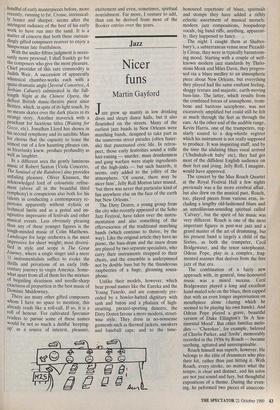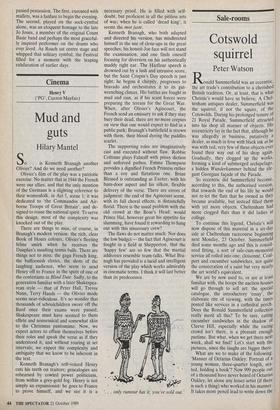Jazz
Nicer funs
Martin Gayford
Jazz grew up mainly in low drinking dives and sleazy dance halls, but it also flourished on the streets. Many of the earliest jazz bands in New Orleans were marching bands, designed to take part in the numerous street parades (often funer- als) that punctuated civic life. In retros- pect, those early festivities sound a trifle hair-raising — murder, mass drunkenness and gang warfare were staple ingredients of the high-jinks — but such hazards, it seems, only added to the jollity of the atmosphere. 'Of course, there may be nicer funs', Jelly Roll Morton later mused, `but there was never that particular kind of fun anywhere else on the face of the earth but New Orleans.'
The Dirty Dozen, a young group from the city who recently appeared at the Soho Jazz Festival, have taken over the instru- mentation and also something of the effervescence of the traditional marching bands (which continue to thrive, by the way). Like the original article they have no piano, the bass-drum and the snare drum are played by two separate specialists, who carry their instruments strapped to their chests, and the ensemble is underpinned not by double bass but by the thunderous raspberries of a huge, gleaming sousa- phone.
Unlike their models, however, which bear proud names like the Eureka and the Young Tuxedo, and are commonly pre- ceded by a bowler-hatted dignitary with sash and baton and a phalanx of high- strutting, parasol-sporting dancers, the Dirty Dozen favour a more modern, street- wise style. They dress in no-nonsense garments such as thermal jackets, sneakers and baseball caps; and to the time-
honoured repertoire of blues, spirituals and stomps they have added a richly eclectic assortment of musical morsels: modern jazz compositions, boopadoop vocals, big band riffs, anything, apparent- ly, they happened to fancy. .
The night I caught them at Shaftes- bury's, a subterranean venue near Piccadil- ly Circus, they were in typically barnstorm- ing mood. Starting with a couple of well- known modern jazz standards by Thelo- nious Monk and Miles Davis, they progres- sed via a blues medley to an atmospheric piece about New Orleans, but everything they played had the same exultant feeling, shaggy texture and majestic, earth-moving bass-line. The latter, which results from the combined forces of sousaphone, trom- bone and baritone saxophone, was not excessively amplified but could still be felt as much through the feet as through the ears. At the other end of the audible range, Kevin Harris, one of the trumpeters, reg- ularly soared to a dog-whistle register which his instrument is not really supposed to produce. It was inspiriting stuff, and by the time the ululating blues vocal arrived (`Uhuhuhuh-oh baby' etc), they had got most of the diffident English audience on their feet and jiving. Jelly Roll, I imagine, would have approved.
The concert by the Max Roach Quartet at the Royal Festival Hall a few nights previously was a far more cerebral affair, but also drew on the musical past. Roach, too, played pieces from various eras, in- cluding a lengthy old-fashioned blues and an antediluvian-sounding spiritual called `Calvary', but the spirit of his music was very different. Roach is one of the most important figures in post-war jazz and a grand master of the art of drumming, but his present band is largely a child of the Sixties, as both the trumpeter, Cecil Bridgewater, and the tenor saxophonist, Odean Pope, play in a complex, frag- mented manner that derives from the free jazz of that era.
The combination of a fairly new approach with, in general, time-honoured music was a mixed success. Cecil Bridgewater played a long and excellent hand-muted solo on the blues, then capped that with an even longer improvisation on mouthpiece alone (during which he seemed to be playing his own hands). And Odean Pope played a grave, beautiful version of Duke Ellington's 'In A Sen- timental Mood'. But other familiar melo- dies — 'Cherokee', for example, beloved of Charlie Parker, and `Jordu', memorably recorded in the 1950s by Roach — became seething, agitated and unrecognisable.
Roach himself was superb, however. He belongs to the elite of drummers who play their kit, rather than just hitting it. With Roach, every stroke, no matter what the tempo, is clear and distinct, and his solos are not just sound and fury, but thoughtful expositions of a theme. During the even- ing, he peformed two pieces of unaccom- panied percussion. The first, executed with mallets, was a fanfare to begin the evening. The second, played on the sock-cymbal alone, was an eloquent homage to the late Jo Jones, a member of the original Count Basie band and perhaps the most graceful- ly inspired performer on the drums who ever lived. As Roach sat centre stage and whipped that solitary cymbal, the Festival filled for a moment with the leaping exhilaration of earlier days.



























































 Previous page
Previous page